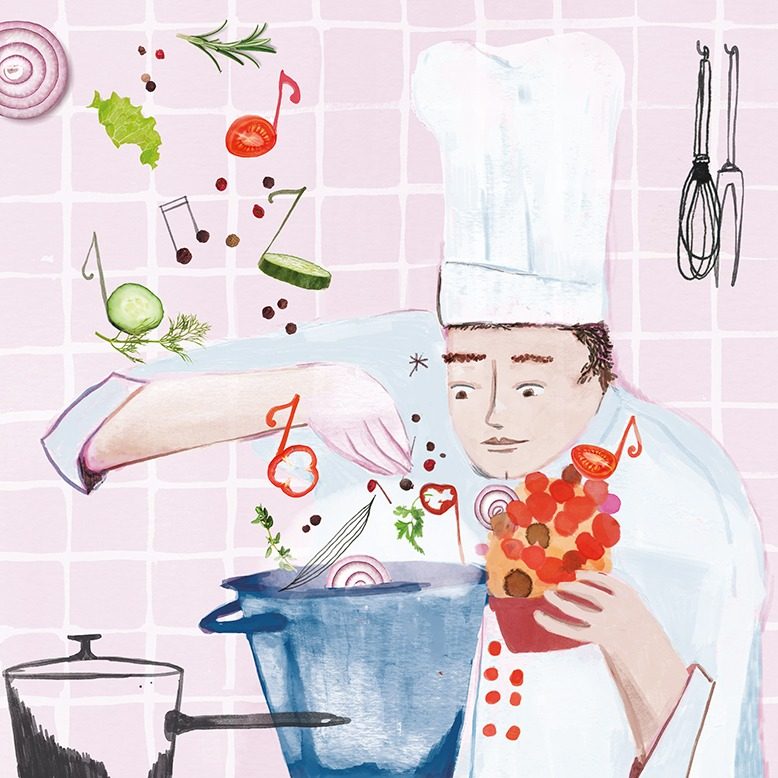
When Tim McLoone dines out, he responds to background music in a physical way. A restaurateur himself, as well as a pianist and bandleader, McLoone can’t help but turn the edge of the table into a keyboard. At least, until his wife notices.
“Beth will see my hands moving on the table and she’ll say, ‘You’re playing that song,’” he admits.
Restaurants thrive on sensory experiences. But while food, drink, service, tableware and decor are obvious, another often goes unmentioned, possibly because it’s invisible. “Music,” says McLoone, who owns 12 restaurants in New Jersey, “is the sound of success. If there’s good music playing, there’s an excitement to being there.”
He’s not only talking about live music. That’s a billed attraction—a drawing card. The topic here is the music you may think you don’t notice. It’s in the background. It may emanate from a jukebox, as at the venerable Belmont Tavern in Belleville. It can make a statement, like the Sinatra stream at Vic’s in Bradley Beach.
Alternatively, a restaurant may subscribe to a streaming service, such as Soundtrack Your Brand, the commercial arm of Spotify, or to Mood Media, formerly known as Muzak. These companies provide a choice of stations, organized by genre or theme. Subscriptions start at about $35 per month.
“It’s safe to say that the music restaurants choose can be a key component of their ambience,” Jason Roth, a communications representative for the streaming service Pandora, said by e-mail, “and can go a long way in setting the mood for unique and memorable dining experiences.”
McLoone says he learned that lesson in 1986, when he purchased the Rum Runner in Sea Bright. “When it wasn’t crowded,” he says, “it was like a morgue.” Music changed the mood. Now, McLoone says, “most of my places have a piano or a band, and all have pre-recorded music playing. We keep the background music at a level where you can still have a conversation.” At dinner, he favors Pandora playlists that include pop, singer/songwriters, R&B and jazz. “I try to stay away from classic rock of the ’60s and ’70s,” he says, “because I don’t want to hear a lot of drums.”
Chris Egan, owner of Egan & Sons in Montclair, grew up in Dublin in the ’70s and ’80s, at the peak of punk and new wave. Egan and his friends made mixtapes to play at his family’s Dublin pub, Bruxelles. “My dad’s place got famous for it,” Egan says, “so when I got here, I knew we had to have music in the bar.”
[RELATED: Are Digital Menus Here to Stay?]
Egan crafts playlists with the help of his friend Bruce Ciccone, a DJ who owned the Loop Lounge dance club in Passaic, which closed in 2014. Egan and Ciccone will spend two to three hours compiling a diverse, five-hour playlist, comprising 100 songs. Billie Eilish, Ohio Players, Depeche Mode and Post Malone made the cut on a recent list.
“It takes a long time—that’s why people don’t do it,” Egan says with a laugh. “You can get an Internet-based jukebox and be done with it. During lunch, we get an older crowd, so you have to play to that crowd, volume-wise. You still want to curate it and play a B side, so it’s not like supermarket or elevator music.”
A 2017 study by HUI Research, part of the Swedish Trade Federation, in partnership with Soundtrack Your Brand, tracked 1.8 million sales transactions and 2,101 customer surveys in greater Stockholm over a period of five months. It found that, if a restaurant played music tailored to its image and customer base, sales increased 9.1 percent over restaurants that played a randomized selection of the most-streamed tunes on Spotify.
“It does make a difference,” Egan says. “I remember we had one guy come up to me after we played [the 1978 remake of] ‘Walk On By’ by the Stranglers, and he said it gave him a snapshot of who we are.”
A commitment to music costs money. Anyone who presents music, live or recorded, in a public setting needs an annual license from the American Society of Composers, Authors and Publishers (ASCAP), Broadcast Music, Inc. (BMI), and/or the Society of European Stage Authors and Composers. ASCAP license fees begin at about $365 per year. Business-to-business streaming services will sometimes include those fees in the cost of a commercial music service subscription.
Egan bought 16 Pro Bose S1 speakers and four Crown XLS amplifiers for five separate areas inside his restaurant, and four speakers for the patio. He bought the equipment about 17 years ago and estimates that today, it would cost about $10,000. “They’re going to be on for 18 hours a day,” he says, “so you want good quality that will last.”
A similar investment helped enhance the reputation of the Merion Inn in Cape May. By the time Vicki Watson took ownership from her parents in the mid-’90s, “more and more restaurants had opened, and this one was languishing,” she says. She hired noted jazz pianist George Mesterhazy. They became a couple and a team. After he bought a Steinway Model B grand piano for $40,000, live music became a focal point at the inn. “We had to sacrifice a few tables in our lounge to make room,” she says, “but worth every square inch.”
Mesterhazy died in 2012, but Watson continues to feature solo pianists performing the Great American Songbook every night. A jazz trio plays in the lounge on Tuesdays. “We ask people in the lounge to keep it down while the trio is performing, because it’s become a listening room,” Watson says. “When you’re eating dinner and you hear the music coming from the other room, it’s still a message. I think it communicates that this is a special evening. People pick up on that.”
